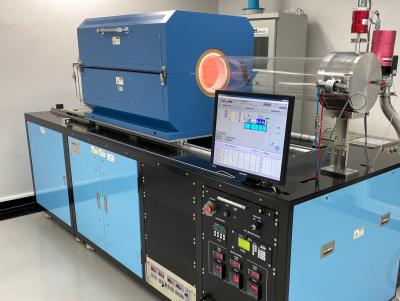There are various methods to produce graphene materials, such as mechanical exfoliation of graphite, liquid-phase exfoliation and reduction of graphene oxide (GO), each with its own set of advantages and disadvantages. Chemical vapor deposition (CVD) is a method of producing graphene that has attracted much attention in the last decade and despite several shortcomings, is considered a leading approach to manufacture graphene, especially for applications like high-performance electronics and sensors, as it can yield high quality graphene sheets with a low defect count and good uniformity.
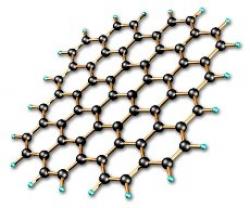
The CVD process
Generally speaking, the CVD method is based on gaseous reactants that are deposited on a substrate. The graphene is grown on a metallic surface like Cu, Pt or Ir, after which it can be separated from the metal and transferred to specifically-required substrates. When the gases contact the substrate inside the heated reaction chamber, a reaction occurs that creates a film of material on the substrate. The process can be simply explained as carbon-bearing gases that react at high temperatures (900â1100â°C) in the presence of a metal catalyst, which serves both as a catalyst for the decomposition of the carbon species and as a surface for the nucleation of the graphene lattice.
As was mentioned before, conditions like temperature, pressure, duration of time and many more can have a significant influence on the process and so must be carefully monitored.
Advantages and disadvantages
CVD can yield high quality graphene, with common characteristics that may include high homogeneity, imperviousness, high purity, fine grains, good control over layer number and more. However, CVD also comes with several disadvantages - namely a relatively high price of the equipment, toxic gaseous by-products and, as stated before, it is a rather sensitive process that is easily influenced by parameter changes. It is important to note that while CVD is a rather expensive method compared to other methods to produce lower-quality graphene, it is still probably the best way (to date) to acquire high quality graphene, since other ways to do that are even more expensive or complicated.
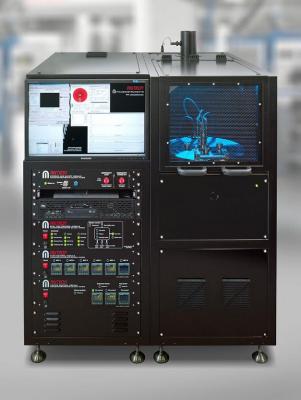
In addition, the separation (or exfoliation) of graphene from the substrate is known as challenging and it is tricky to accomplish without damaging the structure of the graphene or affecting the properties of the material. Another harrowing task is the creation of a uniform layer of graphene on a substrate, something that is continuously proving to not be easy at all.
Some approaches were and are still being developed to overcome this issue, like modifying the concentration of gases and incorporating spin coating methods, but this remains a challenge. However, despite these challenges, it is important to note that CVD is widely considered as an important and promising method to produce graphene, which is already in use, and will probably be even more so in the future, once further advancements are made. It is noteworthy that CVD is already a dominant manufacturing route for many other nanomaterials, and will assumably be in extremely common use once progress is made to resolve the issues that are currently hindering its acceptance.
Market status
While using the CVD method to produce graphene is definitely one the leading approaches in the world, it is still hindered by the challenges mentioned above. Thus, it is currently mostly limited to relatively small volumes and mainly restricted to R&D and academic uses.
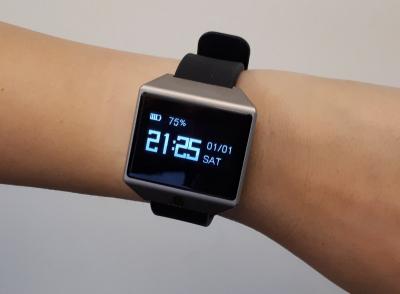
However, graphene sheets produced via CVD methods are used in several applications like sensors, touch screens and heating elements. It is believed that once better answers are found to the questions of price and handling of CVD graphene, many more applications will start to appear.
Looking to buy CVD graphene sheets?
If you are interested in buying CVD graphene sheets, check out the Graphene Catalog that lists various CVD produced graphene sheets from several producers.
The latest CVD graphene news:
An interview with GraphAudio's CEO to discuss the company's CVD graphene-based speaker technology
GraphAudio was established in 2016 to commercialize graphene-based acoustic products based on technology that originated from UC Berkeley and Berkeley Lab. GraphAudio's technology enables electrostatic micro transducers that use CVD graphene sheets.
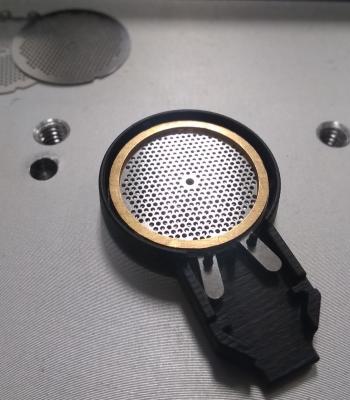
GraphAudio's CEO is Ramesh G. Ramchandani, that previously held executive leadership positions at International Rectifier, Semicoa, nPlay Technologies, ZiLOG and ON Semiconductor, and was a senior advisor for consumer and commercial AI at Google X. Following is an interview with Ramesh to discuss GraphAudio's technology, business and roadmap.
AIXTRON's new graphene and hBN industrial grade reactor goes into operation
AIXTRON has developed, built and installed a new, specific industrial grade reactor for graphene and hexagonal Boron Nitride (hBN) processing on 200 mm epi-wafers. The new CVD tool was developed as part of the GIMMIK research project and has recently gone into operation.
has developed, built and installed a new, specific industrial grade reactor for graphene and hexagonal Boron Nitride (hBN) processing on 200 mm epi-wafers. The new CVD tool was developed as part of the GIMMIK research project and has recently gone into operation.
The GIMMIK project aims to evaluate the production of graphene layers under industrial conditions, spotting weak points and designing ways of eliminating the sources of error. Furthermore, the transfer of the properties of graphene to electrical components by integration into a material environment are to be tested. In parallel, methods for the large-area, contact-free characterization of graphene will be developed, which do not yet exist at present. The GIMMIK research project aims to expand graphene technology for electronic components and to bring it up to a production-relevant level. Participants of the GIMMIK project include: AIXTRON SE, Infineon Technologies, IHP GmbH - Leibniz-Institut für innovative Mikroelektronik, Protemics, LayTec, RWTH Aachen.
An interview with the CEO of graphene developer planarTECH
UK-based planarTECH has recently concluded a successful equity crowdfunding campaign, as part of Graphene-Info's Graphene Crowdfunding Arena. The company's CEO, J. Patrick Frantz, was kind enough to answer a few questions we had and give his advice for graphene companies that consider the equity crowdfunding option.
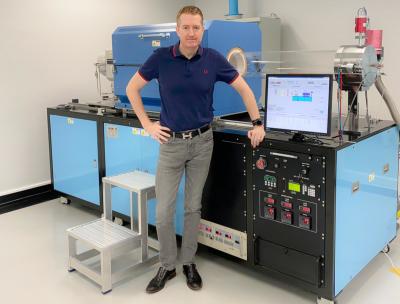
Thank you for this interview. You have recently concluded a successful graphene crowdfunding campaign. Well done. Can you summarize this experience for us?
Well, given the current situation with COVID-19, it was certainly an emotional rollercoaster ride to get through the crowdfunding. If I recall correctly, we launched the campaign in private live mode in January as the pandemic started to unfold. We stayed in private mode for a while but finally went public" in March as the crisis was reaching its most severe point in Europe.
Researchers demonstrate the laser-propulsion of graphene sails in microgravity
ESA-backed researchers from Delft University of Technology in the Netherlands and SCALE Nanotech in Estonia have demonstrated the laser-propulsion of graphene sails in microgravity.
As demonstrated first by JAXA's mission IKAROS (2010) and recently by The Planetary Society's LightSail 2 (2019), using light sails as propulsion system is among the most promising ideas to enable fast and affordable space trips. Not only sails do not require fuel to move, but they save its corresponding costly weight and that of its containing tanks.
planarTECH's graphene crowdfunding campaign reaches 100%, investors are still welcome to participate
UK-based planarTECH has recently launched an equity crowdfunding campaign on Seedrs, as part of Graphene-Info's Graphene Crowdfunding Arena. We are happy to announce that the campaign reached 100% funding today. You can still take part in this exciting campaign, as PlanarTECH still accepts new investors via Seedrs.
PlanarTECH supplies Chemical Vapor Deposition (CVD) systems for the growth of graphene, and has already installed over 65 systems worldwide, to customers such as the University of Manchester, the University of Cambridge, Stanford University and the National University Singapore.
Rolls-Royce to work with Verasrien and Manchester's GEIC on graphene-enhanced aerospace applications
It was recently reported that Rolls-Royce is to work with the University of Manchester’s Graphene Engineering Innovation Centre (GEIC) and its partner Versarien on the use of graphene and other 2D materials used in wiring for next-generation aerospace engine systems.
The initial program of work will use the state-of-the-art chemical vapor deposition (CVD) equipment located within the GEIC.
planarTECH's crowdfunding campaign is already at 48%, reaches out to all investors to participate
This is a sponsored post by planarTECH
Remember, when investing your capital is at risk.
Since planarTECH's business encompasses the entire graphene value chain (from academics to producers to application developers) the company would like to call out to all graphene professionals and others who may be interested to take part in this exciting graphene crowdfunding project.

planarTECH is aiming to raise at least £350,000, but even small investments (as little as £10) are welcome and encouraged since the company is set on making this a graphene community endeavor. Don't miss your chance to be a part of an early stage and promising graphene technology company!
An interview with Patrick Frantz, planarTECH's co-founder and CEO
UK-based planarTECH has launched an equity crowdfunding campaign on Seedrs, as part of Graphene-Info's Graphene Crowdfunding Arena. planarTECH aims to expand its current business and also initiate new graphene endeavors. Investors are now able to participate in this financing round.
Here's our interview with planarTECH's co-founder and CEO, J. Patrick Frantz - who explains the company's technology, business and future plans.
planarTECH's graphene equity crowdfunding project is now live
UK-based planarTECH has launched an equity crowdfunding campaign on Seedrs, as part of Graphene-Info's Graphene Crowdfunding Arena. planarTECH aims to expand its current business and also initiate new graphene endeavors. Investors are now able to participate in this financing round, already at 39% only a few hours after it opened!
planarTECH, founded in 2014, supplies CVD equipment for the production of high quality graphene sheets, as well as other 2D materials. The company was focused on research institutes, and already sold over 65 systems with a customer list that includes Manchester University, the University of Cambridge, Stanford University and the National University of Singapore.
planarTECH releases investor pitch video for its crowdfunding campaign
UK-based planarTECH is launching an equity crowdfunding campaign at on Seedrs, as part of Graphene-Info's Graphene Crowdfunding Arena, and the company now released its first investor video pitch that summarizes the business and technology:
planarTECH is the first company to apply to our Graphene Crowdfunding Arena, and potential investors can currently pre-register for exclusive early access to this campaign. The first step should be to join Seedrs as an investor (which will also enable the participation in future graphene campaigns) and then to apply to planarTECH’s investment page as an interested investor. The company's campaign will go live soon!
Pagination
- Previous page
- Page 4
- Next page
